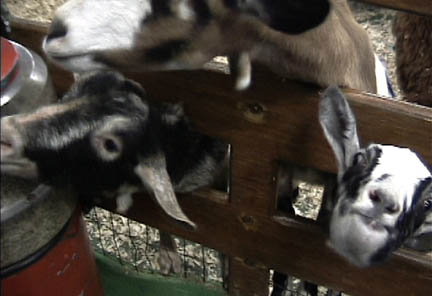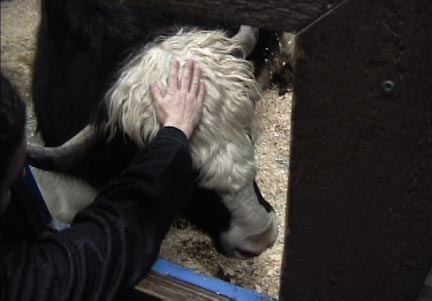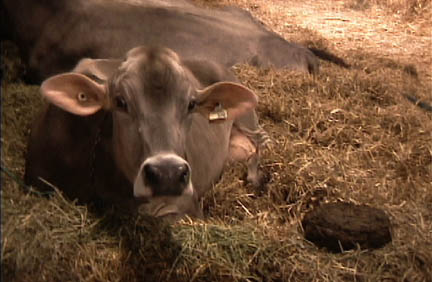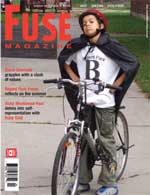
|
Lorna Mills and Sally McKay
Digital Media Tree this blog's archive OVVLvverk Lorna Mills: Artworks / Persona Volare / contact Sally McKay: GIFS / cv and contact |
View current page
...more recent posts

Check out the front pages of the current issue of Prefix Photo for my digital project about the Muskwa Kechika. We have an exhibition coming up in February at the Dawson Creek Art Gallery showcasing work by everyone who participated in the Muskwa Kechika Artists Exploration Camp. I'll be showing a dvd with a little bit of narrative and a lot of goofy home-style effects.
Fascinating story in the Globe yesterday about the Canadian art magazine Blackflash. The next issue has a story by Kyla and James Legard called "The Last Taboo: Childhood Sexuality and Censorship." After what sounds like quite a bit of contention, Backflash has decided to print the story with blank spots & urls in place of the intended illustrations. The "self-censored" images include Mapplethorpe as well as a cutsie painting of a little girl on a park bench by Millais called Cherry Ripe, which the Globe did reproduce online. Globe writer James Adams describes the painting as, "one of the most popular images of the late Victorian era, with prints displayed in millions of homes throughout the British Empire. In the last 25 years, however, some have argued its popularity 'bespeaks the existence of widespread covert pedophilia in Victorian society.'"
I just read a very good essay, "The Folly of Defining 'Serious' Art," by Amy Adler in a book about the complexities of censorship called The New Gatekeepers. Adler says...
"...even in this most justified area of censorship law, the legal solution has proved problematic in two ways. First, in our rush to protect children, we have expanded the definition of child pornography dramatically. It has become so broad that at its borders it endangers speech that almost all of us would agree ought to be protected. For example, the definition is so broad that now something can be 'child pornography' even if the child depicted is wearing clothes. In this way, child pornography law has come to threaten ordinary family pictures as well as important art that depicts children."Hey teacher! Leave those kids alone.
[...]
"Even as it combats the sexualization of children, I believe that child pornography law has also contributed to a world in which we scrutinize children for sexuality in a way that we never did before. In this way it inadvertently fosters the sexualization of children."
Note: I feel a strong affinity to the last statement, above, by Adler. I have decided not to repost the Millais painting, nor to make links to contemporary artists who I feel have unjustly come under this particular legal lens. I don't like the inevitable scrutiny that this context would impose, and I don't want any part of it. Perhaps this is one of the reasons that Blackflash took the action that they did...if so, I think I understand the decision.
 |
 |
 |
 |
Tom Moody has been making digital pogs to add to Michael Bell-Smith's online collection, so I decided to make some too.
Screen images from PLACED curated by Patrick Macaulay
at The Harbourfront York Quay Centre until Dec. 31, 2006

Panorama (2006) Lyla Rye

Doubleswan (2001) Jennifer McMackon

Patriotic (2005)
Benny Nemerofsky Ramsay
Pascal Lievre

Crossing the Bridge (2005)
Vessna Perunovich

Mary in the Promised Lands (2004)
Michael Davey and Brad Harley

Intersection (2006) Dean Baldwin

Discopedia (2004) Ho Tam

The Road to Hell is Paved with
Squished Frogs (2006) Lorna Mills
More cultural loss in Canada. Bad news that Parachute is closing down.

The new issue of Edge is still flogging the science vs. religion horse. Seems like it's still a pretty lively horse, though.
This little precise by Steve Farrar about the Edge origins is interesting. I wasn't aware of the art influence!
...Back in the 1960s, when Brockman was working alongside the likes of Bob Dylan, Andy Warhol and Hunter S Thompson as an avant-garde arts promoter, he was invited regularly to dine and debate with John Cage, the composer and philosopher, and a small group of fiercely bright young artists and scientists. The experience had a profound impact on him." Out of that I got an appreciation for almost the purity of ideas and the excitement of rubbing shoulders with people that could challenge you," he says.
When his friend, the late conceptual artist James Lee Byars, proposed getting together 100 of the world's greatest thinkers to debate with one another in a single room, Brockman shared his excitement at the prospect of an explosion of ideas. And although the project — the World Question Centre — never got off the ground, the concept lived on. Working with Heinz Pagels, the physicist, Brockman later founded the Reality Club so that top thinkers could spar with and inspire one another over dinner. In 1997 he took this informal conversation into cyberspace with the online magazine Edge. It is here that the intellectual elite that he has gathered now thrash out their often contrary views. And it is here that each year on January 1, Brockman posts the group's answers to a different, deceptively simple question. In 2005 it was: "What do you believe to be true, but cannot prove?" Last year it was: "What is your dangerous idea?"

The brilliant Beirut casino will now serve as
your alert to an essay by Pierre Tristam on the
political fallout of the recent war in Lebanon.

The double-phallic pippiclava will now serve
as your alert to a new issue of artfag.

From the Farm to the Fork with a short stop at the petting zoo at the Royal Agricultural Winter Fair. Last weekend we visited the fair to see if animals were happy and loved us.


The portraits in the post below are from the Canadian Agricultural Hall of Fame Gallery, (sponsored by SEMEX) in a room attended by two older gentlemen who were happy and loved us.









L.M. and I have both been participating in a long and sometimes heated (and sometimes hilarious) thread about art criticism over at Simpleposie. The arguments are a tad circular, as people who seem to fundamentally disagree forge the occasional spot of common ground, and then re-polarise. It seems like it might be winding up now, which is a bit of a relief as its time for me to do-as-I-say, not say-as-I-do, but it's been interesting and challenging.

installation view

rabbit space ship

before and after

before and after

video stills from monitors on the bridge (before)

video stills from monitors on the bridge (after)

meet the crew and captain
ENDLESS PARADE OF EXCELLENCE RULES THE KNOWN UNIVERSE!
Because Rob Cruickshank posted a link for the Pinetree Line early warning network of radar bases (equipped with computer technology, if you please). And my hometown was the impeccably strategic location for Station #12.

It had to look like the Soviet Union to keep you safe from the Soviet Union
What of the slide show for the whole pinetree line? (you may well ask) ...it's exquisite.

Did you grow up close to RADAR?

I'm on the editorial committee for FUSE Magazine. There is a launch and screening tomorrow night at Cinecycle. It's gonna be good!
Launch for Volume 29, Issue 4
November 15, 2006
7 p.m. sharp
$10
FUSE launches 'Mobilizing Our Interests' with Regent Park TV. Featuring film screenings by Regent Park Focus and the Balata Film Collective (presented by Vicky Moufawad-Paul)
At CINECYCLE (129 Spadina Ave., Toronto)
In a recent comment thread I was nattering on about neurology & consciousness, thinking I'd already covered this particular topic on the blog. But I realised I was thinking of one of my "Up & Anti-Up" columns for Kiss Machine magazine. Here is an excerpt from issue # 11
During neuroscience experiments in the 1970s, patients were poked on the arm, and asked to note the exact moment when they became consciousness of the stimulus. Brain activity was recorded. Next, the patients were poked directly on the area of the brain that had previously been stimulated. Astonishingly, the brain pokes were “noticed” significantly later than the arm pokes were. This suggested that the brain was receiving information after it was first perceived, but sending that information back in time to coincide with the moment of stimulus. Too trippy? Yes, it is, and of course a lot of people have perfectly non-spooky ways of explaining this data. But it is interesting that quantum theory has accustomed us to hearing such seemingly paranormal ideas from the mouths of credible scientists.
Daniel C. Dennett, a philosopher of consciousness, chalks up the phenomenon to a “temporal smear.” He explains that there is no fixed point when external events are registered in the mind, but rather consciousness is a process; a multi-track continuum. In his book, Consciousness Explained, he presents a more fluid model of consciousness, in which, “at any point in time there are multiple drafts of narrative fragments at various stages of editing in various places in the brain.”
Dennett also chides us (and his colleagues) for clinging to Cartesian Dualism; the old idea that consciousness resides on some separate special metaphysical plane, distinct from lumpen matter. While most people nowadays agree that the mind is a physical process (materialism), many of us still cling to a model of the Cartesian Theatre, in which our perceptions play like film on a screen, a “functional place of some sort where the items of phenomenology are projected.” But according to Dennett, “there is no such theatre, there is no such audience.” This would still require an entity separate from the system. Rather, he holds that the continuous, multiple narratives running in our brains are all there is to consciousness. Dennett’s extreme materialism is very influential, though many people feel he goes too far, especially in his 1998 article “Quining Qualia,” published in Consciousness in Modern Science, in which he denies the existence of perceptual phenomena. Nonetheless, by strictly adhering to physiology, Dennett confronts us with the idea that consciousness does not give us access to a definable external reality.
"History does not offer lessons; its unique constellations of contingencies never repeat. But life does offer the same points, over and over again. A lesson is many-edged; a point has only one, but that one sharp. And the point we might still take from the First World War is the old one that wars are always, in Lincoln’s perfectly chosen word, astounding. They produce results that we can hardly imagine when they start. It is not that wars are always wrong. It is that wars are always wars, good for destroying things that must be destroyed, as in 1864 or 1944, but useless for doing anything more, and no good at all for doing cultural work: saving the national honor, proving that we’re not a second-rate power, avenging old humiliations, demonstrating resolve, or any of the rest of the empty vocabulary of self-improvement through mutual slaughter."From a 2004 New Yorker article THE BIG ONE: Historians rethink the war to end all wars by Adam Gopnik (a writer, who makes me fucking crazy with irritation whenever he wastes time and ink on twee little articles about how precious Parisians are.)

Also, read "Vimy" by Pierre Berton because it's an electrifying piece of history writing.
And next year don't get smug on the new white peace poppy pin because it actually hurts those old darlings still standing (or sitting in their wheel chairs) in shopping malls selling the red ones. (they aren't geriatric war-mongers, they have just remained astounded for over 60 years)

T.A.A.F.I. opened Friday night, so today and tomorrow you should spend all your time and money on art at the Drake & the Gladstone.
One early favourite is room 208 at the Drake where you will find The Movement Movement's brilliant sound piece. Do not fear the headphones, the headphones will not control you. Do not fear Jessica Rose and Jenn Goodwin, they are but mere trotting trollops.

The Arts Vote surveys are in for Toronto's municipal election next week. Out of 44 Wards, only 19 have any candidates who bothered to respond. There are four dudes running in my ward and none of them have answered the survey yet. Their names are Nick Boragina, Joe Pantalone, George Sawision, and Hďmy Syed. I do like Hďmy Syed's website, and it's nice that there are some motivated people running against Mr. Shoe-in Pantalone. Maybe I'll bug them all about the survey. Heck, Rob Ford answered it! Actually, Ford's monosyllabic survey response is recommended reading: hilarious, in a what-the-fuck-is-wrong-with-this-world kind of way.

Annie Pootoogook, Saturday Afternoon, 51 x 66 cm, pentel, coloured pencil.
Image taken from Dorset Fine Arts.
Yay! for Annie Pootoogook. She just won the Sobey's Art Award, which makes me happy.
In a recent post I linked to the Wired article about atheism. Here are some more recent tidbits on the themes of science, religion, and neurology.
Philosopher of consciousness and self-proclaimed atheist Daniel C. Dennett had heart surgery and made it through okay.
What, though, do I say to those of my religious friends (and yes, I have quite a few religious friends) who have had the courage and honesty to tell me that they have been praying for me? I have gladly forgiven them, for there are few circumstances more frustrating than not being able to help a loved one in any more direct way. I confess to regretting that I could not pray (sincerely) for my friends and family in time of need, so I appreciate the urge, however clearly I recognize its futility. I translate my religious friends' remarks readily enough into one version or another of what my fellow brights have been telling me: "I've been thinking about you, and wishing with all my heart [another ineffective but irresistible self-indulgence] that you come through this OK." The fact that these dear friends have been thinking of me in this way, and have taken an effort to let me know, is in itself, without any need for a supernatural supplement, a wonderful tonic. These messages from my family and from friends around the world have been literally heart-warming in my case, and I am grateful for the boost in morale (to truly manic heights, I fear!) that it has produced in me. But I am not joking when I say that I have had to forgive my friends who said that they were praying for me. I have resisted the temptation to respond "Thanks, I appreciate it, but did you also sacrifice a goat?" I feel about this the same way I would feel if one of them said "I just paid a voodoo doctor to cast a spell for your health." What a gullible waste of money that could have been spent on more important projects! Don't expect me to be grateful, or even indifferent. I do appreciate the affection and generosity of spirit that motivated you, but wish you had found a more reasonable way of expressing it.Moral philosopher Mary Midgley goes after evolutionary biologist Richard Dawkins again, this time in a review of his recent book The God Delusion for New Scientist (subscription required for full article).
It seems not to have struck Dawkins that academic science is only a small, specialised, dependent part of what anybody knows. Most human knowledge is tacit knowledge - habitual assumptions, constantly updated and checked by experience, but far too general and informal ever to be fully tested. We assume, for instance, that nature will go on being regular, that other people are conscious and that their testimony can generally be trusted. Without such assumptions neither science nor any other study could ever get off the ground, and nor could everyday life.Apparently, Richard Dawkins has a posse.
When we build on these foundations we necessarily use imaginative structures - powerful ideas which can be called myths, which are not lies, but graphic thought-patterns that shape and guide our thinking. This is not irrational: the process of using these structures is a necessary preparation for reasoning. Thus the selfish gene is a powerful idea, so are the Science-Religion war, Gaia, natural selection, progress, and the hidden hand of the market.
Nick Wade reviews evolutionary psychologist and biololgist Marc D. Hauser's new book for the New York Times.
Marc D. Hauser, a Harvard biologist, has built on this idea to propose that people are born with a moral grammar wired into their neural circuits by evolution. In a new book, “Moral Minds” (HarperCollins 2006), he argues that the grammar generates instant moral judgments which, in part because of the quick decisions that must be made in life-or-death situations, are inaccessible to the conscious mind.Helen Phillips reports on the neurological phenonmenon of confabulation in New Scientist (subscription required for full article).
People are generally unaware of this process because the mind is adept at coming up with plausible rationalizations for why it arrived at a decision generated subconsciously.
Dr. Hauser presents his argument as a hypothesis to be proved, not as an established fact. But it is an idea that he roots in solid ground, including his own and others’ work with primates and in empirical results derived by moral philosophers.
The proposal, if true, would have far-reaching consequences. It implies that parents and teachers are not teaching children the rules of correct behavior from scratch but are, at best, giving shape to an innate behavior. And it suggests that religions are not the source of moral codes but, rather, social enforcers of instinctive moral behavior.
There is certainly plenty of evidence that much of what we do is the result of unconscious brain processing, and that our consciousness seems to be interpreting what has happened, rather than driving it. For example, experiments in 1985 by Benjamin Libet of the University of California in San Francisco suggested that a signal to move a finger appears in the brain several hundred milliseconds before someone consciously decides to move that finger. The idea that we have conscious free will may be an illusion, at least some of the time.
Even when we think we are making rational choices and decisions, this may be illusory too. The intriguing possibility is that we simply do not have access to all of the unconscious information on which we base our decisions, so we create fictions upon which to rationalise them, says Kringelbach. That may well be a good thing, he adds. If we were aware of how we made every choice we would never get anything done - we cannot hold that much information in our consciousness. Wilson backs up this idea with some numbers: he says our senses may take in more than 11 million pieces of information each second, whereas even the most liberal estimates suggest that we are conscious of just 40 of these.
Nevertheless it is an unsettling thought that perhaps all our conscious mind ever does is dream up stories in an attempt to make sense of our world. "The possibility is left open that in the most extreme case all of the people may confabulate all of the time," says Hall.
 | Thicket 1: The Voyage is a collaboration between myself and Von Bark, (with protagonists constructed by Jean McKay); a sci-fi narrative depicting space-time adventures in the brain of the animal spaceship. Do you feel empathy for the Kitty-Cat Captain? |
| The installation opens at York Quay Centre on Friday, November 10th, 6-9 pm and closes on Sunday, December 31st. (Join us in the early evening and get warmed up for TAAFI, there's a mass of great shows --including a new video work by L.M.!-- opening at Harbourfront Centre that night.) | |

Neutrinos They Are Very Small got some coverage today at blogTO. Thanks to Carrie Young for the nice spot!
My brilliant, discerning and politically engaged good friend Nancy Smith Lea is a member of the Toronto Coalition for Active Transportation. TCAT has been bugging Toronto's politicians (and politician wannabes) to articulate their bike and pedestrian agendas before the upcoming municipal election (look here for survey results). I went to their press conference today. It was great! There was a pretty hot lineup of speakers: Dr. Alan Abelsohn, Martin Koob, Glen Murray and Gil Penalosa.
My personal highlights:
I got to finally see Dr. Smog (aka Alan Abelsohn) in person! Once upon a time there weren't very many physicians speaking out about air pollution, except for Doctor Smog. He gave a nice precise summary of the relationships between low-density urban planning and health 'epidemics' such as asthma, heart disease and the dangerous effects of obesity. What does he do when a busy, non-gym-going patient shows up suffering from elevated blood sugar and cholesterol levels? Why he prescribes a commute to work comprised of at least some walking and/or cycling.
Gil Penalosa used to be the Commissioner of Parks, Sports and Recreation in Bogota, where the number of utilitarian cyclists blossomed from 0.5% to 5.8% in just 4 years due to the city's implementation of a comprehensive network of bike paths. He emphasised that planning for active transportation is not magic, nor is it expensive ("peanuts" compared to current transportation budgets), but it does take good leadership: vision, political will and the managerial skill to make it happen.
Glen Murray, chair of the National Round Table on Environment and the Economy (and former mayor of Winnipeg), had me laughing my head off with his description of 22 motivated lawn bowlers in Winnipeg, who showed up continually at council meetings, and "made more phone calls, and stamped more envelopes than any other 22 citizens in the city," therby ensuring that lawn bowling was sacrosanct. He painted an inspiring picture of TCAT-and-friends as a band of increasingly grumpy active transportation advocates who will pester City Hall until our way is the path of least resistance. Murray's big thing is the competition that cities face in drawing and keeping a creative workforce in this age of the knowledge based economy. Apparently living somewhere "interesting" ranks pretty high on people's lists of why they pick certain cities over others (duh! take that you anti-graffiti hounds) and being able to bike to work is a big deal.
Martin Koob, of TCAT, presented a bunch of good research, indicating that while the city has given lots of lip service to bike and pedestrian infrastructure, the well-laid plans are not being implemented, instead the transportation budget is taken up with massive expensive projects like the Front Street Extension and new subway tunnels.
Hats off to TCAT for inspiring a curmudgeon like me, and presenting a uniquely hopeful vision for the future.

This year I carved Crocodile Hunter Steve Irwin's face on my Halloween pumpkin (because the kids love him and he's dead.) (please note the scattered plastic bones in the foreground of the installation shot) I was disappointed when I did not win a prize for the best pumpkin, and that is because R.M. Vaughan was judging the contest, and he is the Worst Fucking Art Critic in Canada.
The other big disappointment is that Steve Irwin actually looks more like Lee Majors. (as one of my asshole neighbours pointed out)

Candy Minx has conducted and posted an excellent interview with AGO curator David Moos. Hats go off to David for participating, but more, fancier hats go off to Candy for her smart and fearless line of questioning!